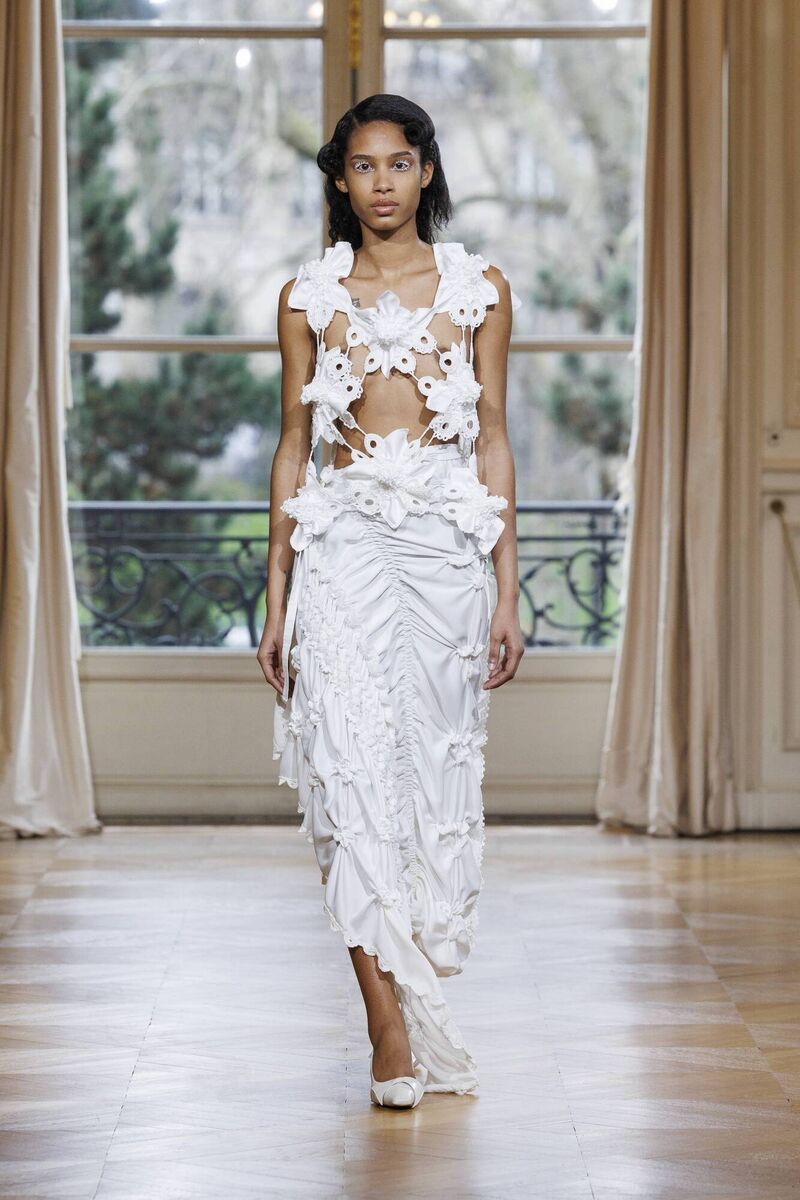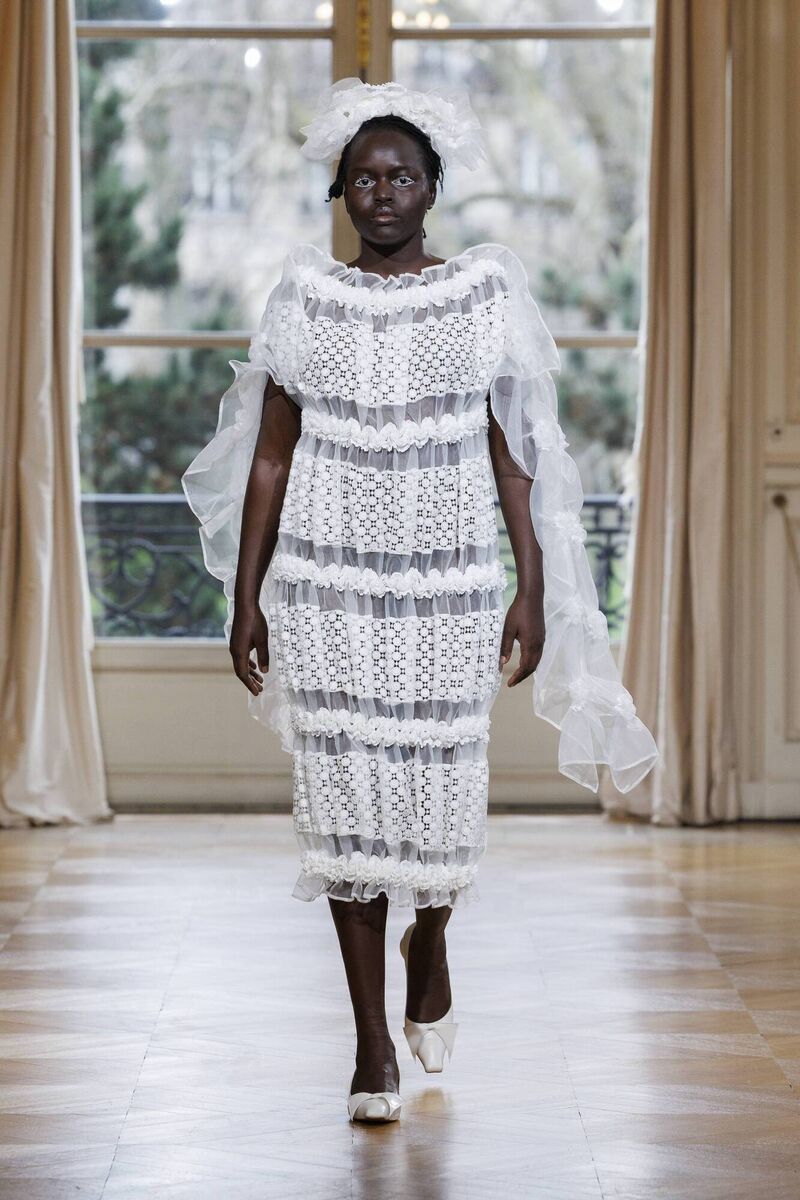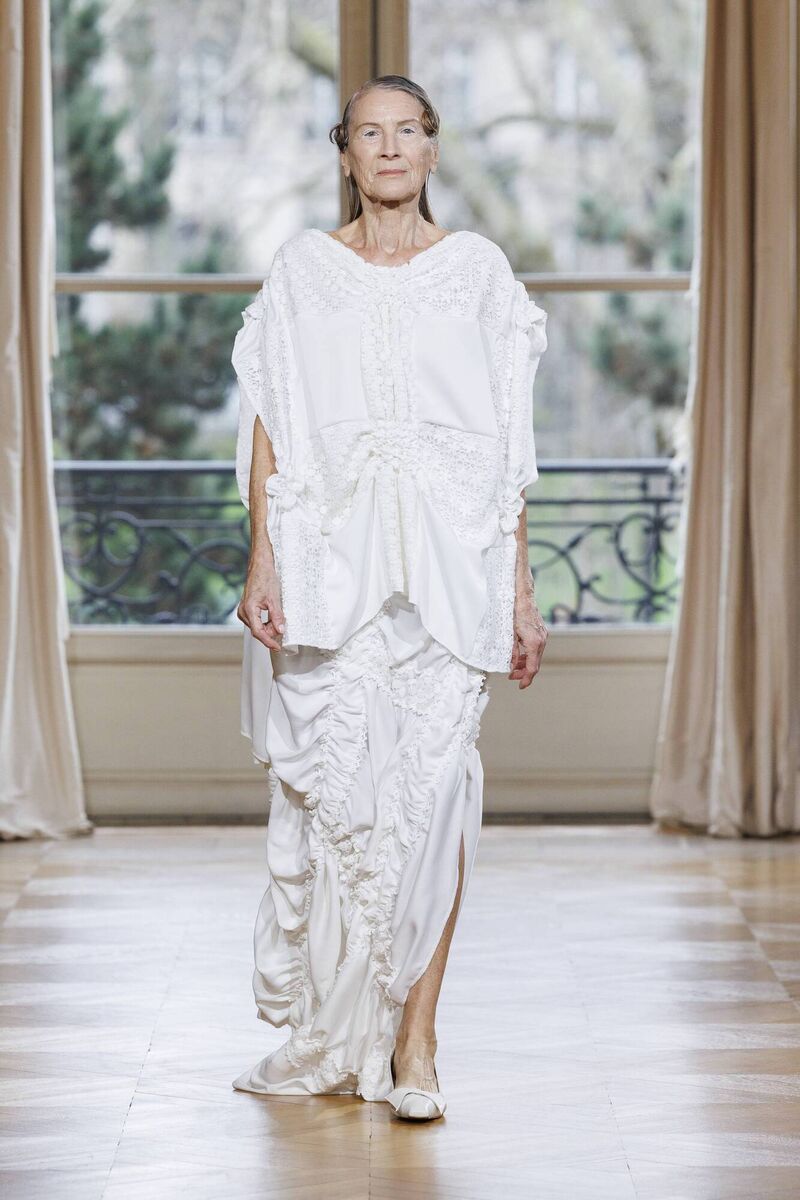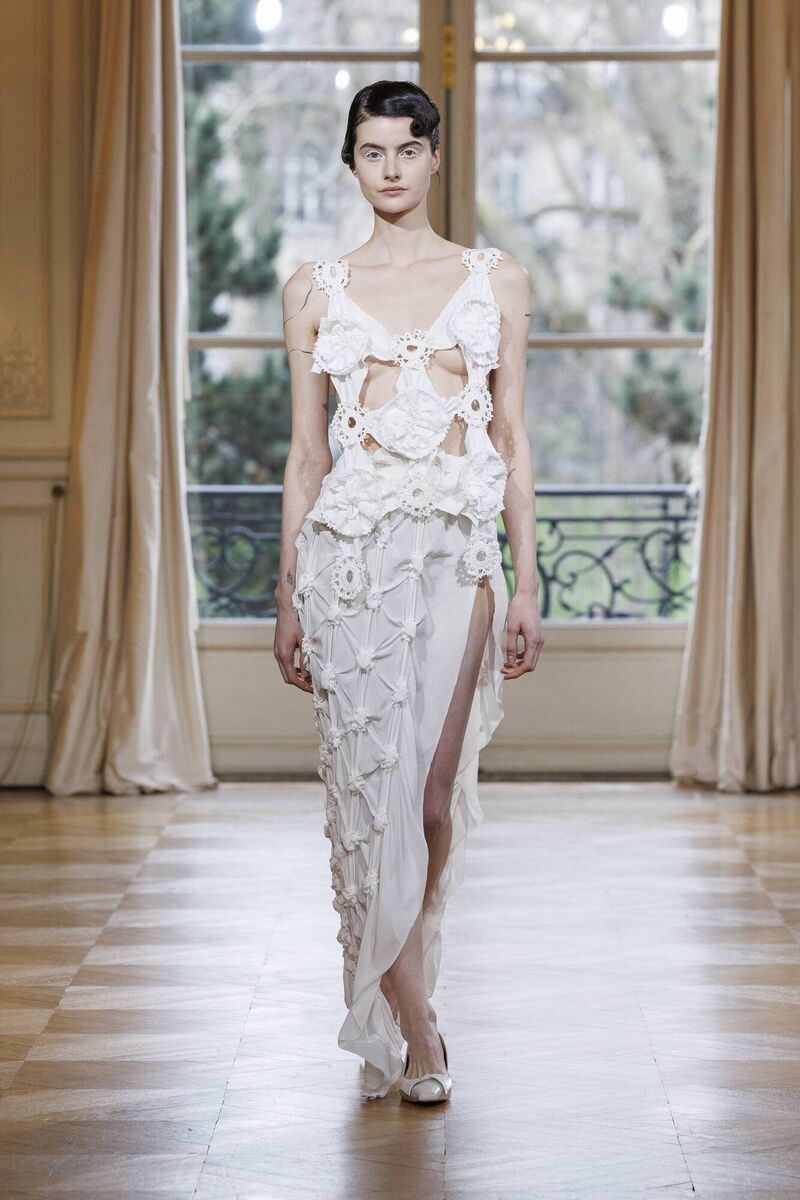Before noon on Friday, March 1, eager editors gathered to congratulate fashion designer Róisín Pierce at the Irish embassy on the occasion of her autumn/winter 2024 collection at Paris Fashion Week.
Moments previously, in the reception rooms, a procession of models had filed through gilded parlours, smocked, ruched, ruffled, and crocheted.
In Pierce’s signature white, the angelic passage was a balm to the pomp and ceremony that typically dominate fashion week.
Entitled ‘O Lovely One, Girl That Fell From a Star’, after a poem that Pierce had written with the poet Michelle Freya, the overarching mood of the collection proffered joy and hope in the face of “humanity’s fracture”, Pierce says.
With political and military conflicts raging the world over, the young Irish talent pondered how the magnitude of craft might offer a salve.
“I’m a sponge to everything that’s taking place in the world, so it’s hard not to channel that message in the collection. While what we do is very design-led, it’s also very emotionally-led,” Pierce says.
Pierce crochets a tale of substance and subtext, via uplifting women’s stories gleaned from Ireland’s dark history.
With reference to how femininity and female sexuality are challenged by the Government, the Catholic Church, and other structures, the Dublin-based designer preserves traditional crafts, like crochet and lacemaking, to enrich her narrative. Despite the loaded context, her work possesses an ethereal lightness and knowing strength.
Róisín Pierce: “I wanted to make something spiritual, but not religious”
While other collections have looked to the institutionalisation of women in Magdalene laundries and to the referendum on women’s reproductive rights, this season took a turn for the conceptual, with a stance on global issues.
A cast of size-, gender- and age-inclusive models was depicted as celestial beings who had fallen from the sky, or goddesses who had emerged from the sea. Pierce listed ancient Roman paintings, Dante’s Paradiso, and Roman goddess Aphrodite, as primary references.
“I wanted to make something spiritual, but not religious,” says Pierce.
They were garlanded in dripping florets of crocheted lace; embroidered lace sourced from St Gallen’s, Switzerland, was blended into a mix of deadstock cotton to create a weightlessness; bouncy smocked flowers were overlaid with transparent organza.
Leaning into the romanticism of Xs and Os, lattice bodies resembled the symbol for a kiss, but the outcome somehow looked like an armour. An inky blue dress — her first foray in to colour — was made from deadstock cotton, renewed with her skilful smocking.
 A look from Roísín Pierce’s Paris Fashion Week A/W 2024 collection, ‘O Lovely One’
A look from Roísín Pierce’s Paris Fashion Week A/W 2024 collection, ‘O Lovely One’
In their delicacy, the pieces came across as protective. Nods to Irene MacWilliam’s ‘Peace Quilt’ played into the notion of textiles as a vessel for collective healing. Ultra-feminine, but never twee or facile, the designer’s exploration of craft and textiles is as fiercely resistant as it is subtle.
Subtlety and care, Pierce says, “send a stronger message than plastered on a t-shirt. If it’s an important message to you, that’s how you should get it across.”
From Rathfarnham, Dublin, Pierce works with her mother, Angie. Together, from her childhood home, they are entirely responsible for the design and production of the label.
“We usually sing off the same hymn sheet,” Pierce says of their working relationship. Angie began practising intricate Irish crochets when her daughter was eight, a skill she passed down to her.
Everything, Pierce says, is “crafted, as ever, by hands we hold dear”. Last March, Pierce became the first designer from the Republic of Ireland to show their namesake brand on the official Paris Fashion Week schedule.
 A look from Roísín Pierce’s Paris Fashion Week A/W 2024 collection, ‘O Lovely One, Fallen From a Star’
A look from Roísín Pierce’s Paris Fashion Week A/W 2024 collection, ‘O Lovely One, Fallen From a Star’
In the span of a year, Irish designers have continued to exceed expectations. Simone Rocha collaborated with Jean Paul Gaultier on a haute-couture collection in January.
Earlier this month, Seán McGirr, as artistic director, issued his highly-anticipated take on Alexander McQueen.
Elsewhere in Paris, Jonathan Anderson marked 10 years of producing cutting-edge designs for Loewe. That Pierce is at the heart of a Celtic twilight is no small feat.
Pierce’s debut, in 2019, was unlike many of her peers’. At the Festival d’Hyères, a fashion and photography event in the south of France, she won the Chanel Metier d’Art Award, which provided her with invaluable support from three of Chanel’s ateliers.
Her deft approach to crochet, smocking, ruching, and embellishment appealed to the discerning judging panel of industry experts.
Five years on, the biggest challenge Pierce faces is how to scale her business. Her model is different: Everything is hand-produced in Ireland, with individual pieces taking between one and 10 days to complete; she shows one collection a year, instead of two.
Her beautifully poetic, tactile approach is one thing, but, at the end of the day, fashion is a business. “It’s quite tough being an independent brand,” Pierce says.
Dover St Market Paris have stepped in to resolve that issue. The brand incubator will assist Pierce in finding new stores for autumn/winter 2024, with production assistance from 2025.
 A look from Roísín Pierce’s Paris Fashion Week A/W 2024 collection, ‘O Lovely One, Fallen From a Star’
A look from Roísín Pierce’s Paris Fashion Week A/W 2024 collection, ‘O Lovely One, Fallen From a Star’
The Irish designer’s work is on sale at Dover St Market’s New York and Los Angeles stores, and this promise of support will give her greater exposure and the capacity to meet the size of orders.
Kate Garvey, brand manager at Dover St Market Paris, who is Irish, but lives in Paris, says, “The opportunity to support the commercial success of an Irish, woman-led brand, within this context, is thrilling, and I am eager to highlight her culturally rich and relevant storytelling on a global stage.”
The partnership is a commitment to a slower approach to fashion, one that values time and craftsmanship, when both of those things are scarce.
Pierce says, “It’s not just a financial backing, but a real respect for each other and creativity.” The brand will continue to show one collection per year and have its primary focus on craft, but this, Pierce says, will allow her to “achieve a lot more, a lot faster”.
The day after the show, glowing reviews were rolling in from industry insiders.
“That was like the rugby team: another win for Ireland,” one Irish guest was overheard saying after Pierce took her bow.
Sarah Mower says Pierce’s “way of speaking can take your breath away”.
 A look from Roísín Pierce’s Paris Fashion Week A/W 2024 collection, ‘O Lovely One, Fallen From a Star’
A look from Roísín Pierce’s Paris Fashion Week A/W 2024 collection, ‘O Lovely One, Fallen From a Star’
Serge Carreira, head of emerging designers at the Fédération de la Haute Couture et de la Mode, the governing body that presides over Paris Fashion Week, told the “[Pierce] drafts a subtle femininity full of poetry. It is soft and bold at the same time. There is something radical in her sweetness.”
With a promising chapter of potential ahead, Pierce says, “It’s challenging to come up with something new every season, but that’s the beauty of working in white, because it forces you to work harder, to consider every transparency, lace, trims, and so on.
“We are committed to creating something new, with a huge focus on design and textiles. The woman we have in mind would admire that: She appreciates new design and thought.”
In 2024, Irish designers are staking their claim. Alongside Pierce, designers Sinéad O’Dwyer and Michael Stewart from Standing Ground are making their voices heard.
A trailblazer for inclusivity, Tullamore designer Sinéad O’Dwyer is widening the scope for luxury fashion to accommodate many more body types than just the rake-thin models that have dominated catwalks for decades. Her story encompasses UK sizes 4 to 32, and models with different abilities, in an honest refusal of convention. While uptake for larger sizes from stores is slower than she anticipated, London-based O’Dwyer is committed to inclusivity.
Last year, she told the “I want people to realise how the lack of pattern cutting for a variety of sizes and shapes was really detrimental to mental health and, overall, the whole nature of ignoring people and discrimination.” Her recent autumn/winter 2024 collection presented at London Fashion Week was entitled ‘Supervisor.’ She studied the codes of corporate dress, with fitted tailoring, mixing them with sexy accents like Shibari ties and casual items like her popular black denim.
Hailing from Co. Clare, Michael Stewart’s label Standing Ground is another refreshing perspective in fashion. His preference for made-to-measure eveningwear is self-assured and rigorous, with a razor-sharp focus on craftsmanship. Best observed up close, where one can study the technical construction that goes into his one-of-a-kind garments.
This April, Stewart is in the running for the prestigious LVMH Prize, an award that provides young talent with an endowment and mentorship scheme to grow their business. Past winners have included Jacquemus and Wales Bonner, both of whom have experienced enormous growth since the prizegiving. Could Stewart be next?















